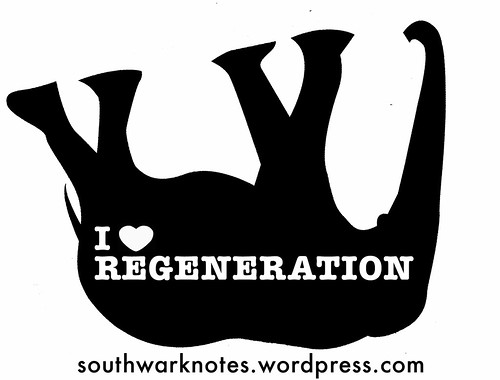A Small and Further Heygate: Demolishing ‘Regeneration’ on Elmington Estate, Camberwell

What were you doing back in the day of December 1999? What Southwark Council’s Housing Committee was doing was agreeing to demolish and redevelop parts of the large Elmington Estate in Camberwell. Built over a number of decades, the Elmington was then comprised of lots of older standard London County Council blocks at Poets Corner, 4 larger slab-like tower blocks from the mid-1950s off Edmund St near to Burgess Park, and smaller 1960s maisonette blocks dotted here and there. The Council Masterplan for this new redevelopment scheme proposed a ‘rolling programme of decant, demolition and new build development within 3 phases’ for the provision of 250 new Council homes, 6 Housing Association homes and 65 private homes for sale. Although we always quite liked the tower blocks, Phase One of this redevelopment process was at least premised on demolition but re-housing of tenants in new council homes on the same site.
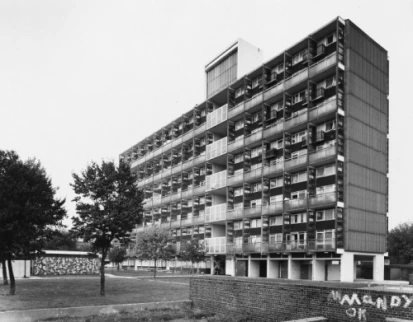
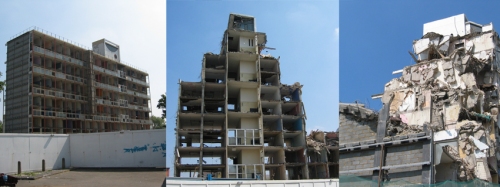
PHASE ONE: PHASING YOU IN
And so it all began: the demolition of 375 existing council homes in the tower blocks Ayton House, Habington House, Dobson House and Durfey House plus some smaller homes and the shops units on Edmund Street and New Church Road. Caspian Street Tenants Hall was also demolished with the promise of a new community space included in the plans. In April 2001, planning consent was granted for the first 136 of a planned 232 new council homes (this new total a reduction by 18 of the original Masterplan’s 250 council homes). The idea was that Phase 2 would provide an additional 89 council homes to re-house those households who were not accommodated in the first phase as well as extra council homes to ‘meet general housing needs’. Phase 3 was intended to provide a further 6 council homes and 77 private houses for sale. The sale of the site was anticipated to cough up about £1 million alongside the redevelopment expenditure being met from the Council’s housing investment programme. Interestingly enough Phase 1 utilised the housebuilders, architects and employers agents already in place at the massive Peckham Partnership sites nearby where hundreds of council homes were demolished and replaced by 2000 homes in a messy mix of different tenures.
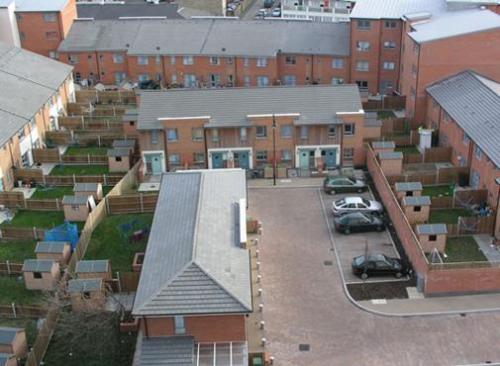
Phase One properly began on 28th January 2002 but the 136 new council homes were only finally completed by June 2005 with a 16 month delay for completion of Phase 1b. 120 of these new homes were let back to most of the original Elmington tenants who had been displaced by the scheme. The remaining homes were allocated (more or less) to ‘households in priority need’. Although the new homes were award-winning architecturally, some tenants complained that structurally they were not as good as the old homes and noise from neighbours through thin walls was really bad: ‘You will never know what privacy is like again. You will hear your neighbours and everything they do. And they will hear you. Your rooms will be smaller. You’ll be paying more for it. One day you’ll wake up and realise that you’d give anything to be back in your old home’ (Elmington tenant, on SE5 Forum). The 18 Phase One households who still needing re-housing would be housed through the 89 new council homes planned for Phase Two.
HOW REDEVELOPMENT BECOMES ‘REGENERATION’
Phase Two of the scheme was not as seemingly smooth as Phase One. Living locally, some of us remember the vacant site at Edmund St, wondering if anything would ever happen there. The Housing Committee decision in 1999 was based on estimated scheme costs of £28,284,600 but by Phase Two the costs were going up ‘due to build cost inflation, the need to buy out further leasehold units, and higher home loss payments’. Now began the big delay and the newer insistence that another way was possible for local regeneration of council estates. Phase Two would now be ‘pursued in a different way’! The planned 95 new council homes for Phase Two and Three was now reduced to only 27 with the scheme now recommended principally as ‘land disposal for the redevelopment of a high-density mixed residential scheme of housing for sale and affordable housing units’. The idea behind this is that the reduced spending on the new council homes and money generated from the sale of the land would be recycled back into this and other Southwark regeneration schemes.
It worth putting into context here that at the same time down the road at Heygate Estate hundreds of tenants were being ‘decanted’ off the estate with a promise of numerous housing projects being built to re-house them. These homes were not built before the estate was emptied and few Heygate tenants returned to housing projects that were built. It’s here we want to flag up the total shift from demolition and re-housing in new council homes that was seen at Elmington Phase One and how the Council’s now adopted ‘different way’ means a whole new regeneration model premised on partnership with either corporate developers (Lend Lease for Heygate) or Housing Association (L&Q, Notting Hill Housing or Family Mosaic). Instead of talking of truly ‘regenerated’ new homes for locals to replace their demolished estates, the spin becomes more about building higher density ‘mixed communities’ to allow new people to settle locally with a constant insistence to this as bringing benefits for all. Local people are now expected to enjoy the ‘opportunity to own their own homes’ through the re-provided ‘affordable’ housing despite entry level for shared ownership homes being way above the average local income.
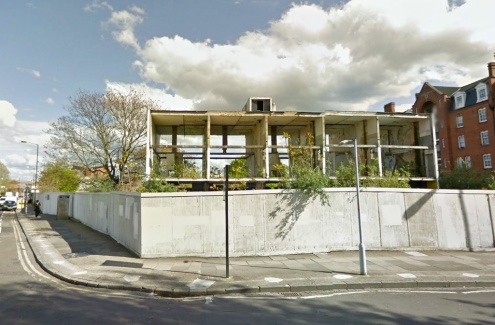
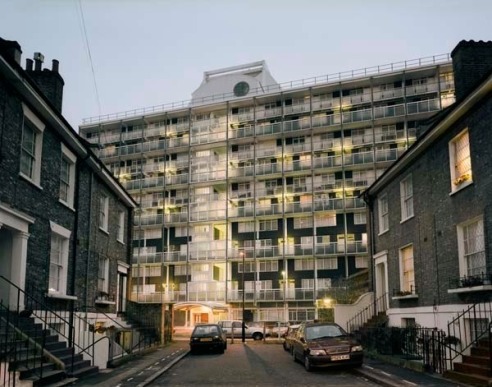
Sears St, old Elmington, Habington House
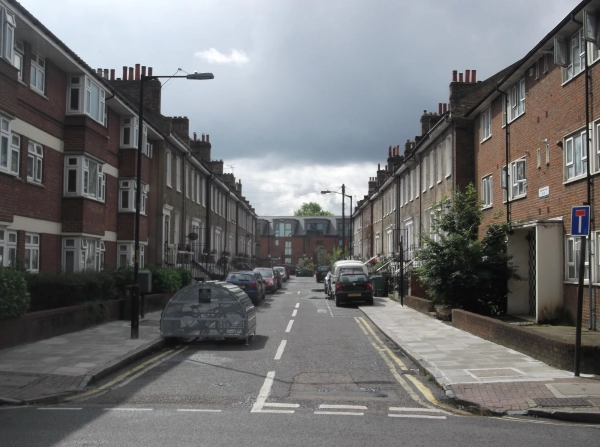
Sears St, new Notting Hill Housing Trust homes
PHASE TWO: DO YOU REMEMBER THAT YOU USED TO ACTUALLY LIVE HERE?
By 2007, the Council was well behind beginning on Phase Two meaning that some tenants decanted in 1999 and 2000 were still waiting for their new council homes. The Council restated their commitment to the scheme and an ‘outstanding commitment to re-house the remaining Phase 1 households who expressed the option to return’. They also planned an extensive refurbishment of the 14 maisonette blocks dotted about the estate and confirmed again that they had ‘no plans to demolish any further Elmington blocks’. In May 2009 however, the Council Executive agreed to establish ‘a new strategic direction for the continued regeneration of the Elmington Estate’. Although there are many factors to consider in regeneration processes (cuts in Government funding for social housing to either councils or Housing Associations, the economic climate, the changing nature of Housing Associations etc), the Elmington scheme (like Heygate and Aylesbury Estates schemes) shows a clear commitment by the Council for socially cleansing areas through this ‘different way’. 10 years before it seemed a no-brainer that demolishing council homes meant coming up with a scheme that would at a minimum include their re-provision for those displaced by the project. 10 years after the Elmington scheme began, the whole thing is shifted towards chucking out local tenants and residents in favour of moving in both slightly wealthier private buyers and incredibly wealth private buyers and calling this a ‘mixed community’.
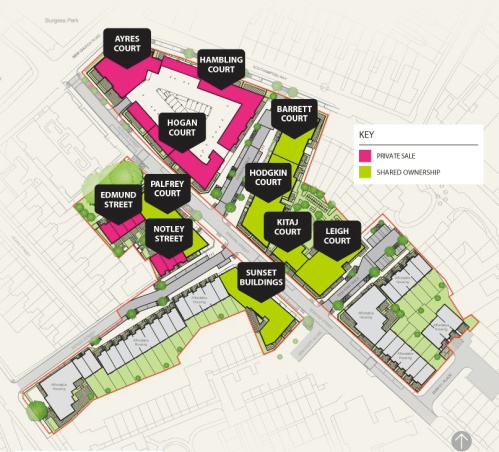
Notting Hill Housing Trust’s Phase Two development
Phase Two came to be developed by the large and aggressive Housing Association Notting Hill Housing Trust who would offer zero social rented homes in the scheme (social rent being the equivalent rent of a council home). Instead they planned to offer 63 ‘affordable rent’ homes – 22 flats at 80% of local private market rents and 41 flats at 65% local market rents. Estimated average week rents in 2011 would be £176 weekly for a one-bedroom flat and £230 for a three bedroom flat – these rents massively more than the council rents on the nearby but not demolished Elmington blocks (2 bed for £120 a week!). The Council’s own feelings on the new ‘affordable rent’ category, initiated by the Government in June 2011, was that it was likely to lead to new homes being unaffordable and was ‘mostly unsuitable’ for 3 or 4 bed flats.
By September 2013, Southwark was attempting to seek a Judicial Review of the iniquities of ‘affordable rent’ alongside three other London Councils. Fiona Colley, Southwark’s then cabinet member for regeneration and planning, said: “We are very keen to seek a judicial review of this decision. Maybe there are some areas of London where rent levels of 80% of market rent are affordable to most people, but they certainly aren’t in Southwark. The implication of the mayor’s decision is that councils will have little power to make sure new affordable housing is really, genuinely affordable for local people.”
By December 2015, when the Council re-examined ‘affordable rent’, they published local private rental figures showing that in Camberwell, average weekly private rents ranged from £302 for a one bed flat to £703 for a 4 bed flat. 65% or 80% of those figures are super high rents, out of the range of most local people. The dramatic increase in local private rents is due, in part, precisely because council estates are being demolished and new private homes are built in their place. The Council also spoke of how such ‘affordable rent’ homes are more likely to push tenants onto Housing Benefit, this in turn subject to a new benefit cap of £23,000 per year. Yet despite all of this, the Council has no problem with Notting Hill Housing Trust building 1000’s of unaffordable homes at Elmington as well as in other large ‘regeneration’ schemes in Bermondsey, Walworth and Peckham too.
Alongside these 63 new expensive ‘affordable rent’ homes, Notting Hill Housing would also build on the site of the old Elmington tower blocks a majority of 192 new private homes and 24 shared ownership homes, the whole thing to be branded as ‘Camberwell Fields’. The scheme contradicted both a ‘saved policy’ from the Council’s document Southwark Plan (June 2007) that sought to avoid a loss of social rented homes in any regeneration as well as the GLA’s London Plan from 2011 that required no loss of social housing in any estate demolition scheme. The GLA’s February 2012 report on the Phase Two plans criticised the Council for ‘not re-providing an equivalent amount of affordable housing floorspace’. The Council arguing however that since the former council homes were demolished over 10 years earlier, the previous number of homes was irrelevant and the site should be now treated as a ‘brownfield site’ as if no homes had ever been there! The GLA pointed out that Phase Two plans would mean result ‘in a net loss of 213 affordable housing units on the site’ if the original 305 council homes on this site was taking into account. (For a brain-curdling mathematical break down of how many actual cheap and decent homes have been lost at Elmington see the very end of this long article).
Notting Hill Housing pulled the usual trick of pleading that providing any social rented housing would make the scheme impossible for them to implement. The Council as ever was willing to be tricked. There is no consolation then in how the Council’s ‘Strategic Vision for Elmington’ asks us to consider that ‘a case would be made that the new homes would be of significantly higher quality, better mix and would contribute to sustainability by supporting a more mixed and balanced community in the area’ rather than actually replacing genuinely affordable homes they knocked down a decade before. Those 15 households seeking to return to a place they were living in 10 years before could not seek solace from the Council who now insisted ‘that during the consultation and re-housing process residents requesting a return to the Elmington site were neither guaranteed a right to return, nor a specific landlord preference’.
The 15 households would be asked what they thought about this in another round of consultation. When the households responded, it was very clear that their concerns echoed promises made 10 years before: they wanted to return to a new Elmington home. Of the 9 households that replied only 3 ‘were willing to return as housing association tenants’. There was ‘disappointment that there has been such a long interval from the time that rehousing took place to the time that new homes will be ready’ and ‘unhappiness that the new properties may not be council homes, given that this was the original choice when re-housing was proposed’. Tenants were also afraid that Housing Association homes ‘will have higher rents than council ones’. How true that is in light of Notting Hill Housing’s love of ‘affordable rent’. With one final symbolic twist, the promised community hall to replace the demolished one on Caspian St was dropped presumably because half of the community had been farmed out to other parts of the borough! Or because the new ‘mixed’ community didn’t need a space for ‘mixing’?
PHASE THREE – PHASING YOU OUT
The May 2009 Executive decision on Phase Two now framed again the possibility of demolition of the 14 multi-home maisonette blocks as part of a future Phase Three project. Refurbishing the blocks ‘would require investment of £10.18m and take 4 years to complete, starting in 2011/12’ and so the idea of demolition, with a Housing Association taking on the development, was back on the table. Elmington tenants who responded to a consultation on this question in September 2009 were not against demolition as they felt that the blocks were in poor condition. What was important though, they argued, was that many residents wanted to remain as council tenants and not become Housing Association tenants and that tenants feared ‘their option to return will not be honoured or that they will not be adequately rehoused’. They also wanted to insure that leaseholders got a fair valuation for their homes and were concerned that ‘elderly and vulnerable residents’ could not cope with relocation because of their ‘emotional attachments to their homes and community’. The Council said ‘to embark on the redevelopment of all blocks is likely to prove challenging when there are a number of major regeneration programmes already underway, (such as Aylesbury and Elephant and Castle). Hence, it would be more practical to move forward with a mixed programme of refurbishment and redevelopment from this point of view’. In the end they decided on a mixed development and refurbish programme for the blocks where development meant demolition for the Harris St Housing Office (site C), two blocks on Benhill Rd (site D), one more block on Benhill Rd and Houseman Way blocks (site E) and flats on Lomond Grove and Broome Way block and Flecker House (site G).
A further consultation in September 2010 produced the same fearful answers that tenants quite rightfully always give on these matters: ‘Being forced to take something I don’t think is suitable (73% of respondents); Waiting too long to be rehoused (61% of respondents; Being outbid for properties I like/ Not finding anything I like in Homesearch (51% of respondents)’. Leaseholders gave similar usual responses: ‘Not getting a fair value for my home (86% of respondents); Losing the investment I have put into my home (57% of respondents); Not being able to afford anywhere (57% of respondents)’.
In a progress report for the Elmington regeneration from March 2011, the then Cabinet Member for Regeneration Councilor Fiona Colley wrote that: ‘It is no surprise then, that throughout the consultation process for the regeneration proposals contained within this report, residents have impressed upon myself and other Cabinet members, their strong concern that the Council makes real progress in making change happen, and that the changes are of benefit to all Elmington residents’. Such a statement massively at odds with the regeneration and displacement scam at hand!
REGENERATION SUMMARY EXECUTION
It might be worth a quick summary at this crucial moment where the Council’s shift in regeneration priorities really starts to harden against those whose homes they are, er..regenerating!
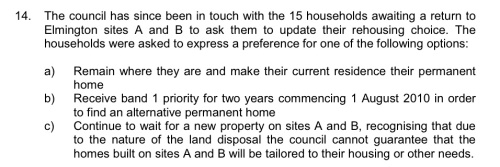
For the Council the way ahead would be the continuation of the long delayed Phase Two scheme. Those still waiting for new homes would now be re-housed by Housing Association who would develop and also buy the land from the Council. After ten years of waiting there were to be no new council homes for those who had stuck out their ‘right to return’ as promised to them in 1999. The promised ‘right of return’ to Phase One’s 15 residents became especially problematic when the Council helpfully expressed that ‘the replacement housing may not be tailored to their housing needs’ i.e. put basically, it’s too expensive! The other options offered to them at such a late date were: 1) stay where they have been living temporarily for the last ten years or 2) find your own home through the Council’s Homesearch, both of these ‘options’ probably the last thing you think would happen to you when you sign up to the Council regeneration promises a decade before. 13 households replied on this choice with 4 households opting to wait for new homes in Phase Two and with 7 opting to find their next home themselves via Homesearch. 1 household decided to stay where they had been originally decanted to.
The next Phase Three stage would extend even further the mash up of Housing Association ‘affordable homes’ (promised social rent, ‘affordable rent’, shared ownership) with the majority of the development being made up of private houses for sale at market prices. The Council saw demolition and regeneration by a Housing Association as an ‘inward investment without cost to the council’ but this is nonsense when leaseholders buy-backs and home loss payments the Council finances are included. According to their own accounts made up to March 2016, the Council had already spent £6,510,807 on the Elmington scheme.
When the Council promises Phase Three residents ‘a choice of rehousing options’ they mean either to a new more expensive home built by the Housing Association or to an existing property elsewhere in the borough through the Councils Homesearch scheme (as 100’s of Heygate tenants had to do to lose their homes). Essentially this means going back on the Housing waiting list but with priority for any old council homes that becomes vacant. As we will see this could be anywhere in the Borough and not necessarily local to where your homes, school, work and neighbours may be. What’s important to add is that tenants and residents had not been shy over the years in criticizing the council over delays, the promises of right of return and on change of landlord and higher rents. But regeneration is like a slow juggernaut coming at you. Should you jump left or jump right or just face it head on and hope it will slow down or stop? Resistance to regeneration happens from day one of such schemes landing on your front door. It is made in the dozens of meetings and interactions tenants have with the Council over the years. Although it may be made visible by public protests such as on Heygate and Aylesbury, resistance is mostly a process happening in the everyday that can be easily overlooked. Tenants and residents had been clear what they wanted and stuck to it, sometime patiently and sometimes not but always trusting the Council to act in their best interests which sadly it does not do, at best, with respect, or at worst, with blatant disregard.
Phase Three residents were clear in their concerns especially from looking back at how slow and deceitful much of the previous Elmington scheme had become. After more consultation in September 2010, tenants had also ‘independently’ presented the Council with a petition signed by 60 people outlining their concerns ‘that they were being displaced as part of the regeneration scheme with no mechanism being put in place by which they could return to the area’. A survey showed that 50% of residents have lived on the estate for more than 10 years, with 35% of residents having lived there for more than 20 years. Many elderly residents reported that they were concerned about the moving process and the practicalities of how it would work.
Other concerns were that refurbished blocks would not be up to a good standard; wanting priority re-housing for residents in new properties constructed on Edmund Street and Harris Street; additional support and options for leaseholders wanting to remain in the area but who were unable to purchase a suitable property on the open market in Southwark; and involvement of residents in the selection process for a developer, amongst other things.
PHASE THREE REALNESS: TENANTS AND LEASEHOLDERS DISPLACEMENT
More consultation happened in December 2010 to ‘meet residents aspirations’ and again tenants were not opposed to demolition of their homes but 80 per cent of respondents from blocks identified for demolition ‘wanting to remain Council tenants as rents were perceived to be lower and space standards better’. Other demands were for guarantees on rent levels and for information to be provided to leaseholders concerning Compulsory Purchase Order processes.
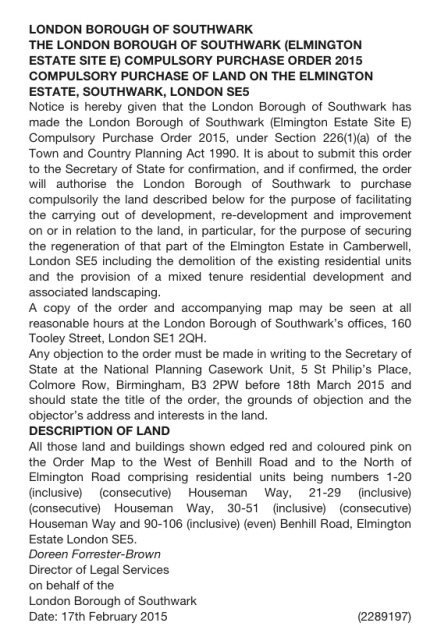
On the subject of Compulsory Purchase the Council had said that ‘CPO will only be used as a measure of last resort’ however in the Cabinet Meeting of 23rd October 2012 they approved the making of a CPO application to the Secretary of State for Communities and Local Government. Again, in the Cabinet meeting of 16th September 2014, they re-approved making a CPO application to the Government. In between the Council was negotiating valuations of leaseholders homes and many leaseholders, despite being unhappy with being forced out of the area (as their compensation did not cover the price of local homes for sale), agreed to low valuations. 4 leaseholders in Site E (Houseman Way and Benhill Road flats), all people who had bought their homes from the Council under the right to buy, still wanted better valuations. What’s important in the story is that when contracts were exchanged between the Council, Family Mosaic and Bellway Homes on 26th March 2014, the contract was conditional on the Council being able to provide vacant possession of Sites C,D,E and G. The Council was clear on why they needed a CPO: ‘More particularly the purpose is to enable the Council to fulfill its contractual obligation to secure vacant possession for Family Mosaic & Bellway Homes.’ Leaseholders wanting a decent valuation to enable them to stay local were, to put it simply, in the way of this obligation.
A CPO public enquiry was held at Council Offices at Tooley Street on 22nd September 2015 where 2 objections were heard. One of the objectors was Caroline Akerejola who owned her home on Houseman Way. She argued that to be forced to sell her property was a breach of her human rights; that her children lived in the property, had grown up in the area and wanted to stay local; that the Council had not maintained the structure of the property in line with it’s responsibilities as a landlord; that the demolition of the buildings on the Order Land (Site E) would mean the destruction of the community; that there were no substantial economic benefits to redevelopment over refurbishment and that refurbishment would have the benefit of maintaining the existing community; and finally that the ethnicity of the Borough had changed over the last 15 years due to the ongoing regeneration of the Borough. These arguments against her and her family’s displacement are the same arguments that have been argued by tenants and residents on Elmington since 1999, as well as during the bigger struggles against such social cleansing on Heygate and Aylesbury Estates. What’s appalling is that a compulsory purchase order can only be made where there is a ‘compelling case in the public interest’ that overrides the leaseholders own right of possession as a leaseholder. It’s also clear that a CPO process no longer regards a leaseholder as a member of that public!
The Council Statement of Case on behalf of its CPO for Elmington does not mention any of these concerns that tenants and leaseholders like Caroline had consistently aired since Phase 1 and that the Council had made public in its own minutes and documents. The Statement has the cheek to say that the regeneration ‘is strongly supported by local residents’ despite years of numerous concerns and criticisms from local tenants and residents. Council simply repeats the regeneration fairly tale of building a mixed community with ‘a commitment to provide decent homes; to produce mixed and balanced communities; to enable the development of new additional homes; and to ensure that new homes are high quality and provide a high proportion for families’. It has no mention of the net loss of council homes and that tenants and former-tenants leaseholders are being chucked out of the area. In Caroline and her family’s case (but it would be the same for many tenants and residents), the Council had the gall to write that while it ‘is sympathetic to the leaseholder’s desire to allow her children to remain in the family home, those adult children do not have an interest in the Order Land (Site E). The Council can only consider the position of the leaseholder herself. However should Mrs Akerejola’s children require re-housing assistance they are free to make an application for housing through the Council’s Homesearch’. These children already had at home at Houseman Way and should not have been advised to go on the Council Waiting List! This is simply disgusting. In light of the Aylesbury leaseholders successfully arguing that their human rights are breached by CPO in 2016, its tragic that, only one year earlier, the CPO processes had been put in place on Elmington with only one quick public inquiry for Site E. As the Aylesbury battle shows, fighting a CPO even at a public inquiry really requires legal representation and this does not come cheap! Few leaseholders want to see more of their cash, savings or future compensation for displacement whittled away in legal battles against the Council.
It’s easy to see why leaseholders give in to the Council’s bullying. All the other Elmington leaseholders either ended up agreeing to the Council’s valuation or are still battling it out with the Council post-Compulsory Purchase and the demolition of their homes. Council data shows that the council ‘has acquired by negotiation pursuant to the compensation code or compulsorily 23 leasehold interests’ at a cost of £3,546,500 and an extra £321,838 for home loss payments. It is still arguing the toss on better compensation demanded by 8 further leaseholders. Such processes of valuation are bitter and our experiences from Heygate and Aylesbury leaseholder battles know how utterly stressful and debilitating they are. Such a long drawn out negotiation on valuations and final CPO process also overrode the residents request that valuation of leaseholders home be outsourced to an independent provider and not done solely by the council’s in-house but flawed Home Ownership Service. Finally, in terms of the Council’s own monitoring of displacement, out of 31 leaseholders, the Council says it only has knowledge of 5 leaseholders who were able to remain in Camberwell. The other 25 it has no idea where they went!
During endless consultations, it was not surprising that that between 40 and 50 per cent of residents wanted to remain within the Elmington area. The Council, on paper at least, recognized that ‘these residents have established significant connections and built up support networks with other residents in the area. Offering these residents the option to return to the Elmington estate will contribute to enabling those connections to remain established’. Around the Elmington area the majority tenure in the area is social rented at 75% of all households. Within Elmington Estate the percentage of households that are Black British (including Caribbean) is at 28% and African at 20%. It’s clear that any loss of social housing here is a disaster for some of these poorest sections of the community in the area. When the Council declares that the Elmington ‘new development will introduce a significant number of new homes available for shared and homeownership for Southwark residents’ it is exactly a description of social cleansing in action. We would make the argument too that contained within such social cleansing is a more hidden ethnic cleansing.

It is worth adding in here that there was resistance to eviction of some of those placed in temporary accommodation in decanted flats. On the morning of Tuesday, 5th May 2015, nearly forty people from Housing Action Southwark & Lambeth, Aylesbury and Guiness Trust activists, some squatters, Lambeth Housing Activists, Green & Black Cross, Reclaim Brixton, Revolutionary Workers Party, People’s Republic of Southwark and others, turned up at fourteen year old Saffi’s family home to resist her eviction. The Council were trying to evict this family for alleged rent arrears: ‘Contrary to what Southwark Council claimed, rent arrears does not automatically make you ‘intentionally homeless’. The family have lawyers who are appealing the decision, but in the meantime collective action kept the family in their home’.
FROM REHOUSING TO DISPLACEMENT: HOW IT HAPPENS
‘It is also worth noting that for every estate regeneration that has started since Labour took back control of the council (so this excludes Aylesbury and Heygate where the process started pre-2010) we have either retained the current stock or plan to increase the number of council homes’.
Richard Livingstone
the then Cabinet Member for Housing in April 2015, posted on SE1 Forum
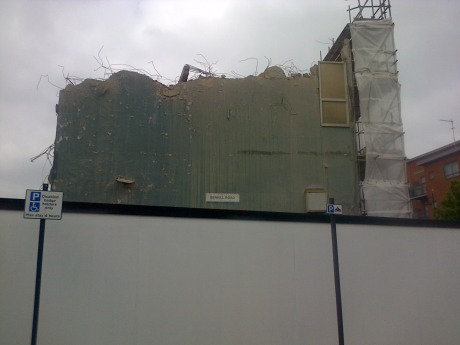
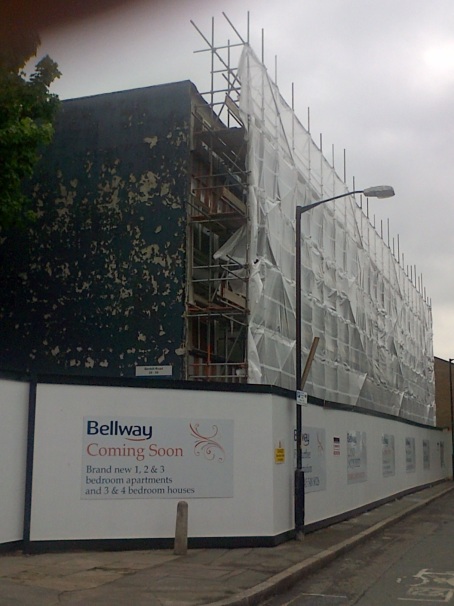
Although our long study of the highly dubious Elmington ‘regeneration’ sadly does not read as good as Sherlock Homes, there is something of a whodunit about it. This is why we love to highlight once again the above quote from Richard Livingstone, the then Southwark Cabinet Member for Housing in April 2015. This said as the Phase Three Elmington demolitions and loss of council homes was just about to start. Whodunit indeed?
So, now for some detail about the ongoing demolition-a-go-go Phase Three with some number crunching fun. The 9 housing blocks demolished in September 2017 were made up of 113 council tenanted homes and 31 leaseholders (144 homes in total). In 2012 the Council teamed up with the Housing Association Family Mosaic who along with mega-profitable mega-builder Bellway Homes would be ‘regenerating’ the sites of the old maisonette blocks. Family Mosaic seems at least to be sticking to the Council policy of 35% of any new development being ‘affordable’ homes even if we know this definition of ‘affordable’ is highly dubious these days.

On the downside they have been noted by the excellent local campaigners on regeneration, the 35% Campaign, to be a Housing Association who play tricks with the ‘social rented’ homes they promise. It’s not yet clear from documents if the agreed ‘social rented’ homes will actually end up being flipped to ‘affordable rent’ homes especially as the Council has no monitoring process to see that what’s agreed really ends up being what is actually built. Council documents from July 2012 talk of the new homes being 65% local market rate ‘affordable rent’ homes for new 1 and 2 bedroom flats (exactly the same as the Phase Two Notting Hill Housing Trust deal)! Needless to say we are watching this very closely.
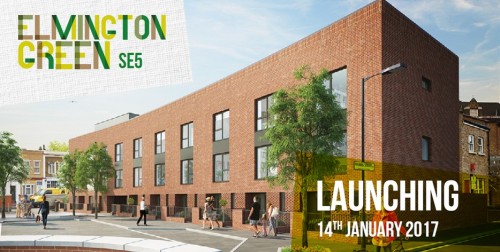
There are 3 sites for new buildings and here is how Family Mosaic and Bellway sold their rebranded ‘Elmington Green’ development to the Council’s planning department:
• BENHILL RD site: 53 homes (32 private / 14 ‘social rent’ / 7 shared ownership
• ELMINGTON RD: 89 homes (56 private / 22 ‘social rent’ / 11 shared ownership
• LOMOND GROVE: 82 homes (52 private / 21 ‘social rent’ / 2 shared ownership
TOTAL HOMES: 140 private homes / 57 ‘social rented’ / 20 shared ownership
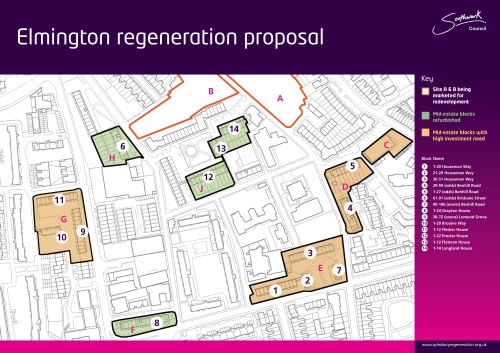
Unsurprisingly tenants of Elmington Estate received a letter from Bellway Homes in November this year stating that for the Lomond Grove site ‘Bellway and the project team have undertaken further assessments and design work, and now consider that revised proposals to provide 104 new homes would be better suited to the site’. Subject to planning permission, the revised Lomond Grove site now asks for 104 homes (67 private / 26 ‘social rent’ / 11 shared ownership) which is basically adding an extra 15 profits-boosting private homes whilst adding in a smaller 5 ‘social rented’ homes. It’s highly unlikely that the Council will refuse this.

In a recent exchange on November 22nd with Leader of the Council Peter John about current demolition of council homes, we were surprised as ever by his claims. We pointed out that 144 homes were being demolished on Elmington right then and that no council homes were part of the scheme to re-house those displaced. His answer was the usual ill-informed one: ‘Council tenants prioritised for re-housing in better accommodation. New social housing delivered at Elmington’. We then pointed out that if less non-council social rented homes were built for rehousing folks then it wasn’t much of a priority. If 113 council homes are demolished and only 62 social rented homes are built, that’s a little bit less than 55% replacement. So where is the right of return to the area they agreed to leave for the other 45% of the community? The discussion went cold when we pointed out these facts and asked where people would go. He said he ‘didn’t know and will look into it’. We are still waiting five months later for an answer. Whodunit, Peter, whodunit? Our phone lines are still open for you to call.
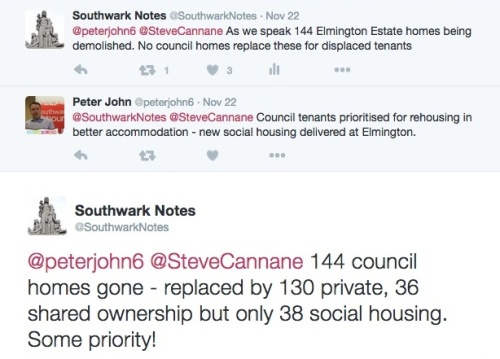
It’s interesting in light of the experience of those Phase One and Two tenants affected by the right of return to see how Phase Three tenants are treated especially as they have been given this right albeit to Housing Association homes and all their discontents. We asked the Council where tenants from Phase Three had gone in the meanwhile pre-demolition of their homes. Figures show that the Council re-housed in Phase Three 103 tenants. Another three tenants choose to move out of the borough.
SE1 – 8 to London Bridge, Borough, Old Kent Rd
SE5 – 34 to Camberwell
SE11 – 2 to Kennington
SE15 – 25 to Peckham
SE16 – 11 to Bermondsey, Rotherhithe
SE17 -11 to Walworth
SE19 – 2 to Dulwich
SE22 – 8 to East Dulwich
SE24 – 2 to Herne Hill
It’s sad but true and normal to move once in a regeneration scheme but we wonder how many tenants who moved out of the area will return or just stay put resignedly? Although from the limited information given we aren’t able to tell, for example, if leaving Elmington for Peckham or Walworth means you have or haven’t gone very far from where you were living, it’s possible to see that many people ended up far away from their original homes. Such stats, of course, do not provide any detail of who may or may not be happy about their move. But the stats do provide a clear example of the movement of council tenants out of the Elmington area to enable the building of mostly private homes on land where hundreds of council homes and tenants used to be. This is what displacement looks like!
REGENERATION: SAY HELLO & WAVE GOODBYE TO 346 HOMES!
If we are to put our mathematical brains to work, something not always easy for us, we can make a final balance sheet of council home losses from all three phases of the Elmington ‘regeneration’ plan.
• COUNCIL HOME DEMOLITIONS: 2002 TO 2016
PHASE ONE: 375 homes (369 council tenants / 6 leaseholders)
PHASE TWO: No demolitions
PHASE THREE: 144 homes (113 council tenants / 31 leaseholders)
LOSSES: 519 homes (482 council homes / 37 leasehold homes)
• COUNCIL HOME CONSTRUCTION: 2002 to 2016
PHASE ONE: 136 Council homes
PHASE TWO: No new council homes
PHASE THREE: No new council homes
If we minus the 136 new council homes that were built in Phase One from the 482 that were demolished over the last 15 years we are left looking at Elmington Estate losing 346 council homes as part its ‘regeneration’, and not fogetting 37 leaseholders (or their families or tenants) turfed out of their homes.
Just like Heygate, Aylesbury, Wood Dene and other ‘regeneration’ schemes, the supposed regeneration of the Elmington is premised on a drastic loss of council housing and its replacement in the immediate area by overvalued private homes and unaffordable rental and shared ownership homes. Decant and re-housing processes are unjust and the Compulsory Purchase Order of leaseholders homes are punishing where no crime or wrong doing has been committed by those who were living on Elmington. Although this piece of writing about Elmington is very long, it shows how smaller regeneration schemes are just as disastrous as the Heygate one was for local people and the effects it brings to a local area – displacement, break up of community, higher rents, loss of community resources and so on. The re-telling of the story comes almost 100% from the Council’s own consultation reports, Council minutes and policy documents. If the Council’s own writing up of their regeneration scheme shows how unfair and shoddy it is for Elmington residents, it’s saying a lot, no?
As we wait for our answer from Peter John on how Phase Three tenants will return to new homes which aren’t there /which don’t exist or are simply unaffordable as tenants consistently said over the years, we can remind him that the promise that there will be ‘no more Heygates’ is clearly a lie. Here on Elmington, we are staring bare face into another Heygate. Promises to build 11,000 new council homes in Southwark over the next few decades are mostly spin despite some new council homes being built recently. The 15 new council homes Southwark built on the old garages of Masterman House on Elmington are on the same street as the very recent demolition of 144 homes. Southwark Council – you do the maths.
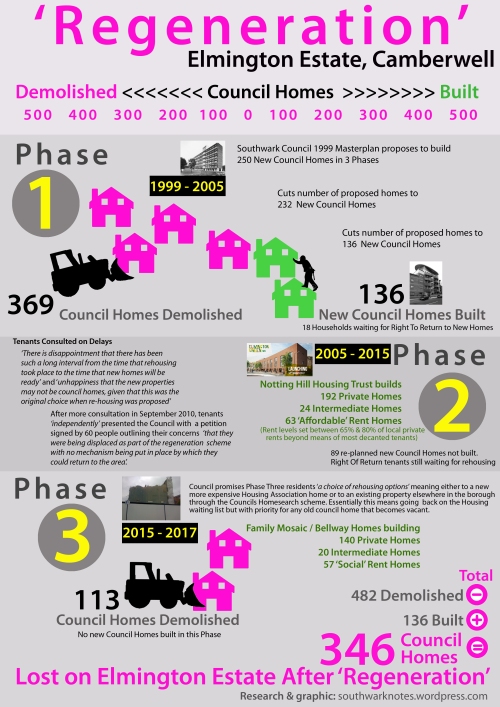
Bellway Homes and ‘Help To Buy’* Scam
In relation to our little Bellway homes tale above, it’s clear that government policies of ‘taxpayer subsidised mortgages’ under the extensive ‘Help To Buy’ scheme favour both massive profits for house builders and landlords, the knock-on effect of high houses prices being that buy-to-let landlords can pick and choose tenants and increase rents every six months because most people can’t afford to buy a new home and have to rent. Peter John insists that, and we quote verbatim, ‘in a housing crisis the way to solve a housing crisis is to build new homes‘, misunderstanding that the real crisis is of a lack of affordable homes and not the myth of lack of available homes. The Guardian in August 2019 reported on a look back at the Help To Buy scheme that ‘between the start of the scheme in April 2013 and September 2018, 38% of all new-build property sales had been supported by loans through the scheme, according to a report by the Commons public accounts committee…More than 5,500 households with an annual income of over £80,000 have been given help-to-buy loans in the past year compared with 4,142 households earning less than £30,000, the government’s own figures have revealed. Well over 2,000 of the richest households who were awarded taxpayer-funded loans, allowing them to buy new-build houses with only a small deposit, had incomes in excess of £100,000‘. Not only are big housebuilding companies over-inflating local houses prices – you’re probably better off not using the scheme – but the actual idea that then scheme gets people out of renting and into proper ownership is bogus as ‘a mere 0.2% of England’s private renting households used help to buy in 2018-19‘.

Figures above for Bellway Homes
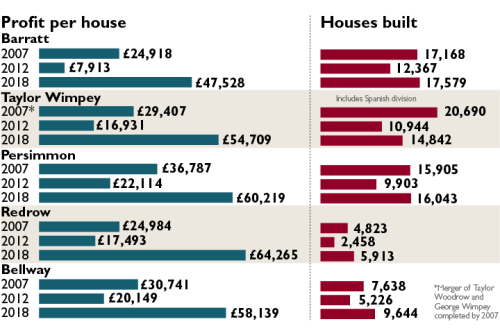
* There is a useful summary of the Help To Buy scam in Chapter One of Danny Dorling’s readable book ‘All That Is Solid: How the Great Housing Disaster Defines Our Times, and What We Can Do About It‘.
>>> All-that-is-solid-the-great-housing-disaster





